For many decades the Sturch family were well-known as confectioners, bakers and publicans in Shipston-on-Stour (Warks)
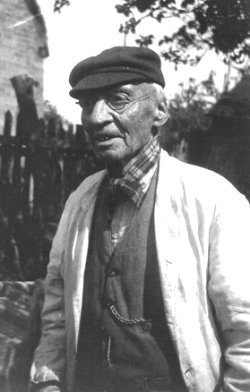
For many decades the Sturch family were well-known as confectioners, bakers and publicans in Shipston-on-Stour (Warks)![]() 1, and numbered among them were several men even more widely-renowned as providers of music for various forms of dancing. On 29 June 1974 Henry William Sturch claimed to have been 'the last of many generations of fiddlers who played for morris dancing etc in Shipston area.'
1, and numbered among them were several men even more widely-renowned as providers of music for various forms of dancing. On 29 June 1974 Henry William Sturch claimed to have been 'the last of many generations of fiddlers who played for morris dancing etc in Shipston area.'![]() 2 His grandfather, Henry, baptised 1 August 1830, was a son of James Sturch, the latter described in the 1841 census as 'Baker J[ourneyman]', revealing a degree of geographical mobility, no doubt facilitated by the possession of a horse and cart, which would additionally have proven useful for their musical excursions. Following official governmental directives to list only the employment description of the head of the household,
2 His grandfather, Henry, baptised 1 August 1830, was a son of James Sturch, the latter described in the 1841 census as 'Baker J[ourneyman]', revealing a degree of geographical mobility, no doubt facilitated by the possession of a horse and cart, which would additionally have proven useful for their musical excursions. Following official governmental directives to list only the employment description of the head of the household,![]() 3 the census enumerator recorded no occupation against the name of the eleven year-old Henry, but we may confidently suggest that he would already have been assisting his father in the baking trade. His transition to fully-fledged follower of the trade is made explicit in the enumeration of ten years later, when aged twenty one and still living at home with his widowed mother, and both are designated 'Baker' (he by the use of the 'ditto' sign). His nickname, 'Badrock Dirty Sugar'
3 the census enumerator recorded no occupation against the name of the eleven year-old Henry, but we may confidently suggest that he would already have been assisting his father in the baking trade. His transition to fully-fledged follower of the trade is made explicit in the enumeration of ten years later, when aged twenty one and still living at home with his widowed mother, and both are designated 'Baker' (he by the use of the 'ditto' sign). His nickname, 'Badrock Dirty Sugar'![]() 4, presumably stems from an association with confectionary. Certainly the same year his relative William Sturch (probably the baker whose ledger for 1825-1830 is still extant
4, presumably stems from an association with confectionary. Certainly the same year his relative William Sturch (probably the baker whose ledger for 1825-1830 is still extant![]() 5) was recorded as having a stall at Banbury (Oxon) Michaelmas Fair, selling, among several other confections no doubt, 'bottles of sweetmeats.'
5) was recorded as having a stall at Banbury (Oxon) Michaelmas Fair, selling, among several other confections no doubt, 'bottles of sweetmeats.'![]() 6
6
In Birmingham, St Phillips (Warks), on 11 May 1853 Henry Sturch married Mary Ann Gillson from Stretton-on-Fosse (Warks), a village close to Shipston. Setting up in a home of his own he started a family, with the first son, Henry William, baptised 12 November 1854, a daughter, Sarah, on 12 October 1856, and another son, Charles William, on 10 June 1860. 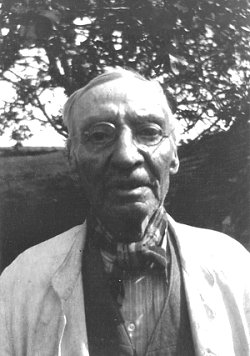 In the register for this latter date Henry's occupation was recorded as labourer, and at the date of census the following year he was enumerated as 'Ag lab', i.e. agricultural labourer. The three children were living in the household, with Henry William and Sarah both given as 'Scholar.' In successive census takings from 1871, however, he was designated as 'Baker', 'General Dealer', 'Hawker', and finally, in 1901, as 'Pedlar', economic pursuits which are facilitated, at least, by a peripatetic lifestyle. He fell foul of the law on at least one occasion, when in July 1861 he was, 'charged with assaulting his father, and committing a breach of the peace; as he had been locked up two days [prior to the court appearance], he was ordered to pay 7s. 6d.; allowed fourteen days.'
In the register for this latter date Henry's occupation was recorded as labourer, and at the date of census the following year he was enumerated as 'Ag lab', i.e. agricultural labourer. The three children were living in the household, with Henry William and Sarah both given as 'Scholar.' In successive census takings from 1871, however, he was designated as 'Baker', 'General Dealer', 'Hawker', and finally, in 1901, as 'Pedlar', economic pursuits which are facilitated, at least, by a peripatetic lifestyle. He fell foul of the law on at least one occasion, when in July 1861 he was, 'charged with assaulting his father, and committing a breach of the peace; as he had been locked up two days [prior to the court appearance], he was ordered to pay 7s. 6d.; allowed fourteen days.'![]() 7 The circumstances of the disagreement remain unknown and unknowable.
7 The circumstances of the disagreement remain unknown and unknowable.
At what age Henry Sturch learned to play the fiddle, and from whom, is unrecorded, but perhaps the family were already musically-active prior to this generation. He himself tutored his sons Henry William and Charles William, writing out three tunes - Blue-Eyed Stranger, Bean Setting, and Processional Morris, a tune similar to The Winster Gallop - in simple notation, using upper and lower case letters.![]() 8 In 1966 Henry Sturch's grandson Henry William claimed that, 'This music was written by my Grandfather over 90 years ago while my father was learning the fiddle for morris dancing. I also used it myself',
8 In 1966 Henry Sturch's grandson Henry William claimed that, 'This music was written by my Grandfather over 90 years ago while my father was learning the fiddle for morris dancing. I also used it myself',![]() 9 and additionally, eight years later, that, 'He taught Charlie (my father) to play the fiddle early in life also the banjo.
9 and additionally, eight years later, that, 'He taught Charlie (my father) to play the fiddle early in life also the banjo. 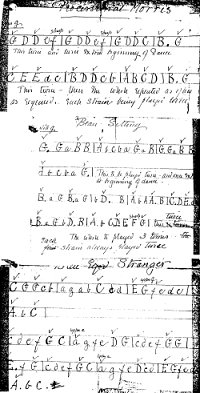 My uncle Ned, who was the elder he taught the banjo and uncle took on the cornet as well and was a founder member of Shipston Town Band in 1912. They both carried on in this area with Morris and Folk Dancing also Sam Bennett of Ilmington and a Mr. Kinchin of Chipping Campden.'
My uncle Ned, who was the elder he taught the banjo and uncle took on the cornet as well and was a founder member of Shipston Town Band in 1912. They both carried on in this area with Morris and Folk Dancing also Sam Bennett of Ilmington and a Mr. Kinchin of Chipping Campden.'![]() 10
10
One of Cecil James Sharp's informants claimed that there never had been a morris dance set based specifically at Shipston, but there once was one composed of dancers from the nearby communities of Tredington, Honington and other surrounding villages.![]() 11 This polyglot team is likely to have been active around the middle of the nineteenth century. Citing oral family tradition, Henry Sturch, it was claimed, travelled widely playing for morris sets,
11 This polyglot team is likely to have been active around the middle of the nineteenth century. Citing oral family tradition, Henry Sturch, it was claimed, travelled widely playing for morris sets,![]() 12 which perhaps included this one. Activity with specific named sides remained unrecorded, but we may suggest that one such might have been that from Stretton-on-Fosse, his wife's birth place. Another dance which sounds very much like a morris was described by a Shipston blacksmith named Hands (almost certainly John Sheldon Hands, baptised in that town on 4 July 1854), in 1911:
12 which perhaps included this one. Activity with specific named sides remained unrecorded, but we may suggest that one such might have been that from Stretton-on-Fosse, his wife's birth place. Another dance which sounds very much like a morris was described by a Shipston blacksmith named Hands (almost certainly John Sheldon Hands, baptised in that town on 4 July 1854), in 1911:
The dance lasted a week from Monday, May 1st to the following Saturday. Danced by men of different trades, shoemakers, sweeps, tailors, blacksmiths, etc. The Maypole itself was the usual Jack in Green with hoops at the top and a T or cross, all covered in greenery and flowers. The dancers wore knee breeches, stockings and pads of bells on their shins like Morris men. They carried withy-sticks, 2 feet long, and jigged about, clapped hands, changed sides, etc. The Head man talked a lot and made fun with the crowd: very sharp in his answers. The dancers wore shirts covered with ribbons, rosettes, etc. They numbered 9 or 10. Slept out at night under hedge [sic] or wherever they could. A pony-cart accompanied the dancers to carry the Maypole when going from village to village. Maypole very heavy. There were usually three or four sweeps, "as black as Newgate". None of the others had any distinctive marks or their trade. Music supplied by a man with fiddle and another with tambourine.The accompanying musicians may, at times, have been drawn from the Sturch family. Henry Sturch certainly provided musical accompaniment to social dancing, and when interviewed by Sharp in 1909 told of how he used to, 'play cushion dance to Greensleeves. Fiddler in middle of room', also making reference to the country dance 'Three Meet', which he called the 'Half-way dance.'13
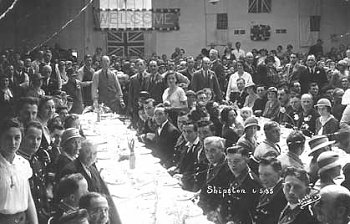 William Nathan Wells of Bampton (Oxon) related how he had toured extensively throughout the locality, fiddling and playing for his own solo dance performances, 'I went to Kingham Club, where I met with a very old fiddler. The old chap was very much took up with me although a stranger, Mr. Stirt. There was another good gipsy fiddler there, by the name of Green. They were both very anxious to play to my dancing. We had a crowd of about 100 around us, but I never found one that would challenge me.'
William Nathan Wells of Bampton (Oxon) related how he had toured extensively throughout the locality, fiddling and playing for his own solo dance performances, 'I went to Kingham Club, where I met with a very old fiddler. The old chap was very much took up with me although a stranger, Mr. Stirt. There was another good gipsy fiddler there, by the name of Green. They were both very anxious to play to my dancing. We had a crowd of about 100 around us, but I never found one that would challenge me.'
 Still living in his parents' home at the date of the census, on 2 April 1871, sixteen year-old Henry William Sturch was enumerated as 'Musician', indicating the early personal exploitation of his specific talents, and we may suggest his participation at Cherrington a few months later, as noted above. He married Angelina Wilson on 20 January 1876 at Atherstone on Stour (Warks). His wife and two children, Catherine Millicent (registered in Atherstone during the fourth quarter of 1876) and Charles Wilson (Shipston, fourth quarter, 1879), are enumerated in Atherstone in 1881, boarding in the home of James Archer, with her occupation given as 'Hat Box Maker.' Henry William, however, is nowhere to be found at any location in the entire country.
Still living in his parents' home at the date of the census, on 2 April 1871, sixteen year-old Henry William Sturch was enumerated as 'Musician', indicating the early personal exploitation of his specific talents, and we may suggest his participation at Cherrington a few months later, as noted above. He married Angelina Wilson on 20 January 1876 at Atherstone on Stour (Warks). His wife and two children, Catherine Millicent (registered in Atherstone during the fourth quarter of 1876) and Charles Wilson (Shipston, fourth quarter, 1879), are enumerated in Atherstone in 1881, boarding in the home of James Archer, with her occupation given as 'Hat Box Maker.' Henry William, however, is nowhere to be found at any location in the entire country.
Three months later, Henry Sturch and one of his sons, presumably either Henry William or Charles William, were present at the 'Annual Sunday School Treat' held at Shipston on 29 July 1881, where, 'The children first sat round for a substantial tea in the Rectory grounds. Sturch and son meanwhile discoursing merrily on the violin ... At 8 o'clock they left the field and returned to the Rectory where they had another feast of cakes, buns and sweetmeats. No less than 240 packets of sweets were distributed among them.'![]() 19 The sum of two pounds, eleven shillings and four pence (modern equivalent: roughly £2.57) was paid to Sturch, but this included the cost of the provisions, some of which, at least, they also provided; and when the event was repeated the following year they received only five shillings (25 pence) for the musical entertainment alone.
19 The sum of two pounds, eleven shillings and four pence (modern equivalent: roughly £2.57) was paid to Sturch, but this included the cost of the provisions, some of which, at least, they also provided; and when the event was repeated the following year they received only five shillings (25 pence) for the musical entertainment alone.![]() 20 At the celebrations held in Tredington (Worcs) to commemorate Victoria's Golden Jubilee on 21 June 1887, 'The proceedings were opened by service at the parish church, a procession to which was formed, headed by Sturch's string band.'
20 At the celebrations held in Tredington (Worcs) to commemorate Victoria's Golden Jubilee on 21 June 1887, 'The proceedings were opened by service at the parish church, a procession to which was formed, headed by Sturch's string band.'![]() 21 Once again, this is likely to have featured Henry and one or more sons, and it seems likely that they would have additionally provided music for social dancing at some point during the day. Perhaps also they were the 'string band' which, 'discoursed dance music to the delight of a numerous company', at the Club Feast at Salford (Warks) in mid-July 1887.
21 Once again, this is likely to have featured Henry and one or more sons, and it seems likely that they would have additionally provided music for social dancing at some point during the day. Perhaps also they were the 'string band' which, 'discoursed dance music to the delight of a numerous company', at the Club Feast at Salford (Warks) in mid-July 1887.![]() 22
22 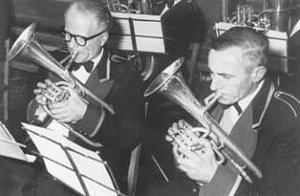 A report on the Jubilee celebration at Little Wolford (Warks), held a short time earlier, noted that, 'Harry Simm's band from Shipston was in attendance'.
A report on the Jubilee celebration at Little Wolford (Warks), held a short time earlier, noted that, 'Harry Simm's band from Shipston was in attendance'.![]() 23 Given that there is no one of this surname in Shipston at the date of any census taking, this is likely to be a misspelling of the name, and the band was really that of Harry Sturch.
23 Given that there is no one of this surname in Shipston at the date of any census taking, this is likely to be a misspelling of the name, and the band was really that of Harry Sturch.
In 1891 Henry William was designated 'General Labourer.' Two children are living in the household, and the places of birth given suggest that the family had been actively peripatetic. Lilian Hilda, then aged two years, was apparently born in Belper (Derbyshire), and John Henry, aged eight months, in Birmingham.
Recounting tales apparently relating to this man, one informant noted how, 'He was a contemporary of fiddler Jeffreys of Shipston and Sam Bennett at Ilmington ... There were slack times and busy ones and the local fiddlers worked in teams, one substituting for the others. They were in great demand, not only for Morris Dancing, but for village fetes, barn dances, birthday parties, and ... even children's parties.'![]() 24
24
And subsequently rehearsing information collected from Harold Jeffreys, a son of the member of this small aggregation of fiddle players, claimed that:
They knew music inside out and composed music for local dances. Harold's father worked in the Mill here for his main source of living. He was a great friend of Henry Sturch and also Sam Bennett. They used to go round all the villages and play in the village Inns, and met a grand welcome. Harold tells me that not only could his father read music but compose it. On one occasion he wrote a score for a polka, while riding in a haywagon from Stratford On Avon to Shipston On Stour. On reaching home he hurried off to Weston Park to try it out on one of his great admirers, the Earl of Camperdown. It was a great success. Harold learned early to play both the fiddle and the mandolin, he says.25
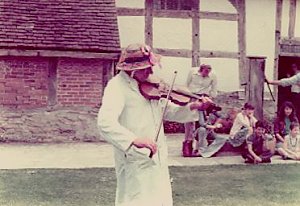 Jeffreys the fiddle player may probably be identified as Charles Thomas Jeffreys, baptised in Long Compton (Warks) on 18 January 1857, and enumerated in Shipston in 1881 as 'Musician.'
Jeffreys the fiddle player may probably be identified as Charles Thomas Jeffreys, baptised in Long Compton (Warks) on 18 January 1857, and enumerated in Shipston in 1881 as 'Musician.'
Charles William Sturch was also said to have played for morris sides which visited Shipston![]() 26, although given his birth date this is unlikely to have occurred much before, say, 1875. In 1881, still at home, he was working as an agricultural labourer, but ten years later the census gives him as 'Musician.' In 1897 he remarried, to Gertrude Sarah Cumbley (registered at Shipston during the 4th Quarter), presumably following the death of his first wife Mary (although no registration of death has been found), and in 1901 was noted as 'Bricklayer's Labourer.' There were, however, certain marital problems, as revealed by a case held at a petty session in Shipston on 17 November 1900:
26, although given his birth date this is unlikely to have occurred much before, say, 1875. In 1881, still at home, he was working as an agricultural labourer, but ten years later the census gives him as 'Musician.' In 1897 he remarried, to Gertrude Sarah Cumbley (registered at Shipston during the 4th Quarter), presumably following the death of his first wife Mary (although no registration of death has been found), and in 1901 was noted as 'Bricklayer's Labourer.' There were, however, certain marital problems, as revealed by a case held at a petty session in Shipston on 17 November 1900:
Charles Sturch, Water Lane, was summoned for using indecent language on the night of 2nd November. - P.S. Street said he saw defendant go into his own home, and heard him abusing his wife. Defendant's wife said "You wouldn't care if I died to-morrow." She was sobbing upstairs, while defendant was swearing downstairs. - Defendant said his wife was his principal witness, but she was ill and could not attend. He asked for an adjournment till next meeting. - Granted.One morris dance occasion which may perhaps be laid at the feet of Charles William Sturch occurred during the festivities held to celebrate the anniversary of the birthday of William Shakespeare, in Stratford-upon-Avon (Warks), during April 1907:27
Quite one of the most interesting features of the Birthday proceedings was the Morris dancing, which was given during the afternoon at the Market Cross, Old Town, Rother-street, the Bancroft gardens, and outside the Town-hall, and attracted thousands of spectators, who fully appreciated the really clever display given by local talent ... The local men, J. H. Payton, Sidney Batchelor, F. Read, G. Chandler, Keeley, G.; Gardner, and Staley, were taught by a lady from the Esperance Club, who has been engaged in similar work all over England, and the dances given have been collected together by Mr. Cecil Sharpe [sic]. The style of dance is not the old Warwickshire, but the Crewe and Nantwich, and by reason of diligent practice the men have acquired an agility which contrasted favourably with the movements of the Bidford troupe which visited the town two or three years ago. In Stratford and district there is quite a respectable number of old Morris dancers, most of whom learned in Ilmington. The fiddler on this occasion was a well-known Ilmington character, whose father fiddled at Morris dances before him ... The dances given included Rigs O'Marlo, Laudanum Bunches, and Truncles [sic], names which may have some traditional meaning, but seem obscure. Suffice it to say the troupe exhibited considerable skill and we trust that they will be overburdened with engagements now that their fame has been cast abroad. It is only fair to acknowledge the enthusiasm displayed by Mr. F. W. Evans in getting the troupe together, and generally superintending the practices.28
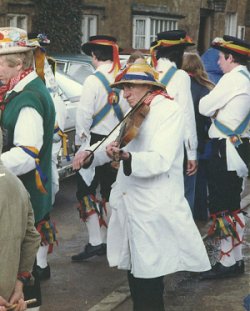 Clearly the dances named are not from Crewe and Nantwich, but reflect those collected at the Esperance Club during the previous twelve months from William Kimber (1872-1961), of Headington Quarry (Oxon). The 'well-known Ilmington character' has on occasion been assumed to be Sam Bennett (1865-1951). But, despite multiple interviews with Bennett, his father was never mentioned as having played for the morris (or, indeed, having played the fiddle at all), and it seems more likely that Charles William Sturch was the musician on this occasion.
Clearly the dances named are not from Crewe and Nantwich, but reflect those collected at the Esperance Club during the previous twelve months from William Kimber (1872-1961), of Headington Quarry (Oxon). The 'well-known Ilmington character' has on occasion been assumed to be Sam Bennett (1865-1951). But, despite multiple interviews with Bennett, his father was never mentioned as having played for the morris (or, indeed, having played the fiddle at all), and it seems more likely that Charles William Sturch was the musician on this occasion.
Henry William Sturch, a son of Charles William, was born on 5 September 1909, and, per family tradition, was taught to play the fiddle by his father when still a boy. As late as the mid-nineteen twenties both men were travelling far afield, nearly into Oxford, at least (the vicinity of Stonesfield was named as one area visited), playing at local events.![]() 29 There were 'family music evenings' at home, with the father on banjo, and both his son and Sam Bennett of Ilmington on fiddles.
29 There were 'family music evenings' at home, with the father on banjo, and both his son and Sam Bennett of Ilmington on fiddles.![]() 30 Henry William Sturch, it was claimed, 'regularly played early this century for many a day in Shipston', and in 1937 substituted for Bennett when the latter broke his arm 'at Mayday and other events.'
30 Henry William Sturch, it was claimed, 'regularly played early this century for many a day in Shipston', and in 1937 substituted for Bennett when the latter broke his arm 'at Mayday and other events.'![]() 31
31 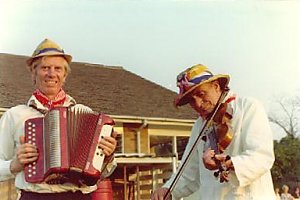 He is, in addition, likely to have been the 'H. Sturch' involved in a 'social meeting in the Friends' Meeting House' in Shipston on 12 February 1931, at which 'a capital programme of songs, recitations, piano-forte solos, violin solos, and dances was given.'
He is, in addition, likely to have been the 'H. Sturch' involved in a 'social meeting in the Friends' Meeting House' in Shipston on 12 February 1931, at which 'a capital programme of songs, recitations, piano-forte solos, violin solos, and dances was given.'![]() 32 He was also taught to play cornet with the Shipston Town Band, and was a member of that group for fifty years, beginning in 1924, at the age of fifteen.
32 He was also taught to play cornet with the Shipston Town Band, and was a member of that group for fifty years, beginning in 1924, at the age of fifteen.![]() 33 One bandsman who knew him during his later years recalled that 'Fiddler' always played second horn, never standing out, not a 'soloistic player', but always being there, supporting the band and turning out to play. 'A real bandsman.'
33 One bandsman who knew him during his later years recalled that 'Fiddler' always played second horn, never standing out, not a 'soloistic player', but always being there, supporting the band and turning out to play. 'A real bandsman.'![]() 34 As recently as the mid-nineteen seventies he was influential in shaping the morris dance revival at Ilmington, and also played for the team on occasion.
34 As recently as the mid-nineteen seventies he was influential in shaping the morris dance revival at Ilmington, and also played for the team on occasion.![]() 35
35
Henry Sturch, described in the register as 'Marine Store Dealer', was buried on 29 January 1910, aged seventy-nine.![]() 36 His son Henry William preceded him, dying on 4 February 1900, and the other son Charles William passed away during the first quarter of 1941. With the death of grandson Henry William on 25 August 1980 an extended dynasty of music-makers in Shipston-on-Stour was finally laid to rest.
36 His son Henry William preceded him, dying on 4 February 1900, and the other son Charles William passed away during the first quarter of 1941. With the death of grandson Henry William on 25 August 1980 an extended dynasty of music-makers in Shipston-on-Stour was finally laid to rest.
Keith Chandler - 6.10.06
1. Although Shipston-on-Stour remained administratively in the county of Worcester until 1 April 1931, geographically it was generally considered to have been in Warwickshire even before that date, as was Tredington, mentioned later.
2. University of Sheffield, National Centre For English Language and Cultural Tradition, Russell Wortley MSS., field notebook 1974/5, f.11, interview with Henry William Sturch, Shipston-on-Stour, 29 June 1974.
3. Details of these instructions can be found at <http://www.rootsweb.com/%7eengcots/Enum.html> (accessed 21 September 2006).
4. Notes on the Sturch family compiled by Chris Green, Ilmington, from the oral traditions of Henry William Sturch, his wife, and a sister, Mrs S Goode. Copy sent to the present author on 2 October 1980.
5. Warwick, Warwickshire County Record Office, CR 224.
6. Banbury Guardian, 23 October 1851, 2.
7. Jackson's Oxford Journal, 13 July 1861, 8.
8. See image. Chris Green, at that date of Harpenden (Herts), showed these three cards to me at Alsager (Cheshire) on 10 March 1984.
9. London, Vaughan Williams Memorial Library, Lib. Coll. GRQ 357/8, letter from Chris Green, Ilmington, to Barbara Newlin, 29 December 1975.
10. Vaughan Williams Memorial Library, David Bland MSS., letter from Henry [William] Sturch, Shipston-on-Stour, to Bland, 17 February 1974. Thanks are due to Paul Burgess for alerting me to this source, which also contains the original letters from Leonard Bradley and Shipston-on-Stour Town Council, cited below. Quotes are from Paul's transcriptions, given in an email to the present author, dated 14 April 2002. For a brief history of the Shipston Band, see <http://web.mac.com/gsharp2/iWeb/ShipstonTownBand/About%20Us.html> (accessed 21 September 2006). For brief details of Sam Bennett see below. Kinchin of Chipping Campden remains, as yet, unidentified.
11. Cambridge, Clare College, Cecil James Sharp MSS., 'Folk Dance Notes' 2, f.36, interview with 'Mr. B', Shipston-on-Stour, 1911, with transcription in four bound volumes by Maud Karpeles, and typed by Roy Leonard Dommett, in Vaughan Williams Memorial Library. For the sum total of data available see my Morris Dancing in the English South Midlands, 1660-1900. A Chronological Gazetteer (Enfield Lock: Hisarlik Press, for the Folklore Society, 1993); republished, in completely revised form, on Morris Dancing in the English south Midlands 1660-1900. Aspects of Social and Cultural History (Stroud: Musical Traditions Records, 2002) MTCD250 [CD-ROM].
12. Vaughan Williams Memorial Library, Lib. Coll. GRQ 357/8.
13. Sharp MSS., 'Folk Dance Notes' 2, ff.34-35. Though undated in the original, the notes fall between items dated 7 March and 7 June 1911. I am indebted to Malcolm Taylor, Librarian at the Vaughan Williams Memorial Library, for providing me with a scan of the relevant pages from the bound transcription.
14. Vaughan Williams Memorial Library, Sharp MSS., 'Field notebook' iv (14 August - 3 September 1909), interview with Henry Sturch, Shipston-on-Stour, August 1909, with fair copy in Sharp MSS., 'Folk Dance Notes' 1, f.78.
15. Notes on the Sturch family compiled by Chris Green.
16. Banbury Beacon, 29 September 1871, 4.
17. Banbury Advertiser, 17 June 1886, 5.
18. William Nathan Wells MSS., 'Written by W. Wells, on Morris Dancing', January 1914 [now lost]. Transcribed by Roy Leonard Dommett, there are copies in the Dommett and Chandler MSS. Portions of the manuscript are reproduced in 'William Wells 1868-1953. Morris dancer, fiddler and fool', Journal of the English Folk Dance and Song Society 8, no.1 (1956), 1-15.
19. Bland MSS., letter from Leonard Bradley, Shipston-on-Stour, to Bland, 14 February 1974.
20. Bland MSS., letter from Leonard Bradley, to Bland, no date [but annotation '14.5.74' written in Bland's hand].
21. Shipston News, 2 July 1887, 8.
22. Shipston News, 23 July 1887, 8.
23. Shipston News, 16 July 1887, 8.
24. Bland MSS., letter from Leonard Bradley, 14 February 1974.
25. Bland MSS., letter from Leonard Bradley, no date [but annotation '14.5.74' written in Bland's hand]. This informant, still living in 1974, is likely to have been the Harold Percy Jeffries whose birth was registered at Worcester during the first quarter of 1910. The 3rd Earl of Camperdown, Robert Adam Philips Haldane-Duncan (1841-1918), enumerated in Mayfair, London, in 1871 as 'Civil Lord of the Admiralty', is the most likely candidate.
26. Notes on the Sturch family compiled by Chris Green.
27. Banbury Beacon, 24 November 1900, 8. No follow up was reported in subsequent issues.
28. Stratford-upon-Avon Herald, 26 April 1907, 2.
29. Chandler MSS., interview with Chris Green at Alsager 10 March 1984.
30. Notes on the Sturch family compiled by Chris Green.
31. Ibid.
32. Evesham Journal, 21 February 1931, 16. Another participant on this occasion was an 'M. Sturch.'
33. Bland MSS., letter from Leonard Bradley, no date [but annotation '14.5.74' written in Bland's hand].
34. Chandler MSS., telephone interview with Dave Birch, Tiddington (Warks), 10 June 2006.
35. For further details of this involvement see the web site of the Ilmington Morris Men, at <http://www.ilmingtonmorrismen.org.uk/> (accessed 21 September 2006).
36. Bland MSS., letter from Shipston-on-Stour Town Council, to Bland, no date.
Each census is indexed thoroughly and searchable, and although there are inevitably some errors in transcription and guesses at words written in some of the more illegible enumerators' hands, a little lateral thinking regarding search parameters will often yield the required entry. The great advantage of this site is the ability to access images of the actual pages of the original enumeration volumes. The entire 1881 census, in transcribed form only, is freely available on the website of The Church of Latter Day Saints, Salt Lake City, Utah, at www.familysearch.org/Eng/Search/frameset_search.asp?PAGE=census/search_census.asp , and is again comprehensively indexed and searchable. Many census returns for numerous communities in the Cotswold region (including those from Blockley for 1851 to 1891 inclusive) are freely available, in transcribed form only, at www.rootsweb.com/%7eengcots/Census.html The 1901 census is searchable at www.1901census.nationalarchives.gov.uk , where many personal details are freely given in transcription, but the image of the original page requires payment of a small fee.
Baptism and marriage registers for many, though not all, communities in England have been transcribed and indexed by The Church of Latter Day Saints. These are also freely searchable at www.familysearch.org/Eng/Search/frameset_search.asp
There was a legal obligation from 1837 onwards to register all births, marriages and deaths with the civil authorities. In practise, however, many such, especially among the travelling community, escaped this directive. Full details are available, by subscription, at www.ancestry.co.uk/search/rectype/vital/freebmd/bmd.aspx An ongoing transcription, still incomplete, is freely searchable at http://freebmd.rootsweb.com/cgi/search.pl
Article MT187
| Top | Home Page | MT Records | Articles | Reviews | News | Editorial | Map |